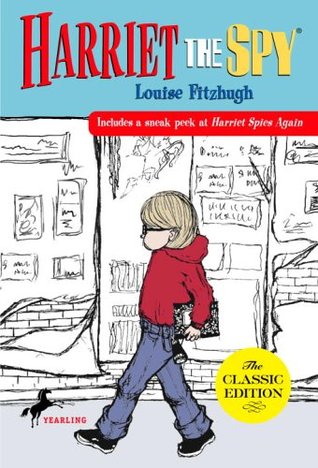 I remember this book being very popular when I was a kid, but I had never read it. As it was with all those Beverly Cleary books, I just felt it was high time I read this one.
I remember this book being very popular when I was a kid, but I had never read it. As it was with all those Beverly Cleary books, I just felt it was high time I read this one.
I really enjoyed this book. I wasn't sure, at first, if I would like Harriet. She was certainly precocious, but came across a little know-it-all-ish. Also, since her family is wealthy - they employ a cook as well as a nurse / nanny for Harriet - I wasn't sure if she'd be relatable. But, the more she wrote in her notebook, and the more she behaved like any other kid, the more I appreciated her.
Summaries of this book usually focus on how Harriet's notebook gets into the wrong hands, but she actually doesn't lose the notebook until a little more than half-way through the story. Mostly, I find this book is about people. Just people. As Ole Golly, Harriet's nurse, says, “There are as many ways to live as there are people.” And Harriet is keen on trying to understand all the people she encounters. Her astute observations and insights, the social commentary and self-reflection, all had quite a lot of depth, especially for someone who is supposed to be 11 years old.
I liked that this book takes place in Manhattan. When I sat down and thought about it, I don't think any of the other children's books I've read recently take place in a big city! It's always a suburb, or a farm, or a small town set in the old days. It was nice to have a setting with a bit more excitement.
What really impressed me about this book, though, was how it was able to depict, in a way accessible to children, the true horrors of bullying and the cycle of abuse. Certainly, when Harriet lost her notebook and all hell broke loose, there was plenty of blame to go around; Harriet was not blameless. However, there is no denying that Harriet was mercilessly bullied, and then what happened? Being bullied made Harriet angry, and made her lash out in retaliation, despite that type of behavior being entirely out of character for her. All too frequently, those who are abused will turn around to become abusers. Luckily, Harriet's parents did care about her (even if they did mostly outsource her upbringing), and Ole Golly came through with her spot on child-rearing expertise.
So, why not 5 stars? Well, as with other books I've rated 4 1/2 stars, the book on the whole was great, but there were just a few small things that didn't sit right with me. I mean, I understand that Harriet was practicing her spying in preparation for becoming a spy when she's older, but I was a bit uncomfortable with the idea of her actually sneaking into other people's houses, and looking into the windows of strangers!
Also, this book was published in 1964, when there wasn't the hypersensitivity to gun violence and terrorism that there is today. I'm definitely a product of current times, because it did give me pause when guns were mentioned early on, even though it was mostly harmless, in the context of bad guys in a story Harriet was making up. But also, Harriet's friend Janie really gave me the creeps. Not only was she always talking about blowing things up - and doing dangerous chemistry experiments in her room to reach her goal! - but the illustrations of her really made her look disturbing. Oh, and, the word "stoned" was used twice, and that didn't seem appropriate for the lower end of the recommended age range for this book, which is grades 3-7.


No comments:
Post a Comment